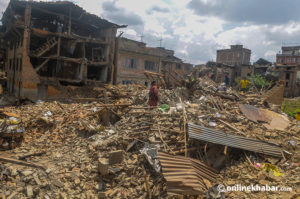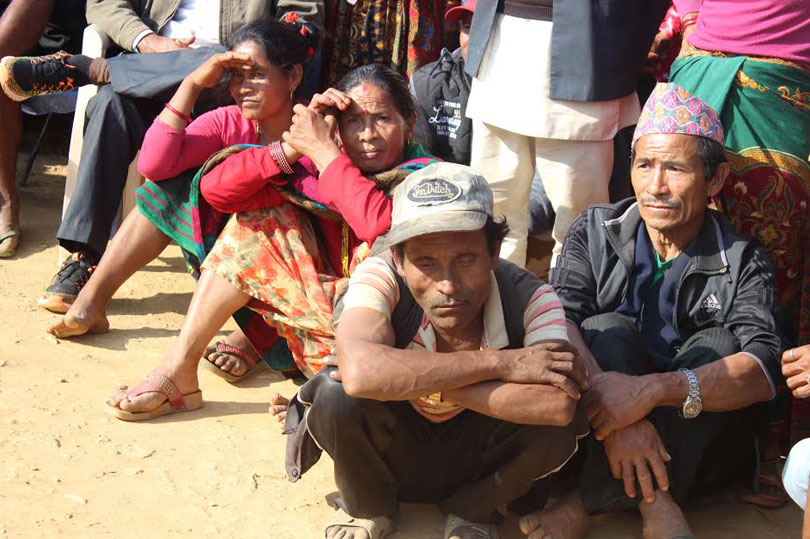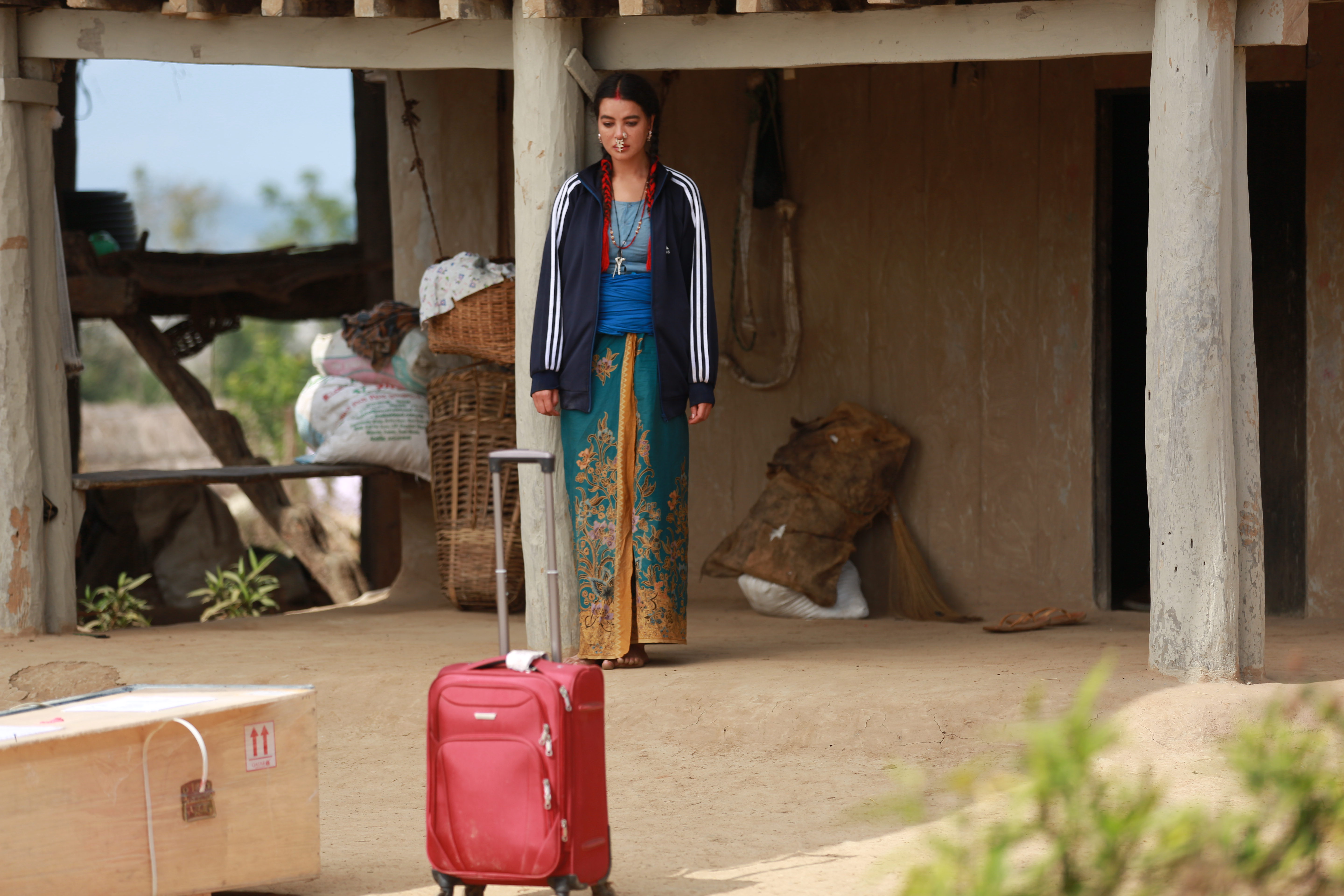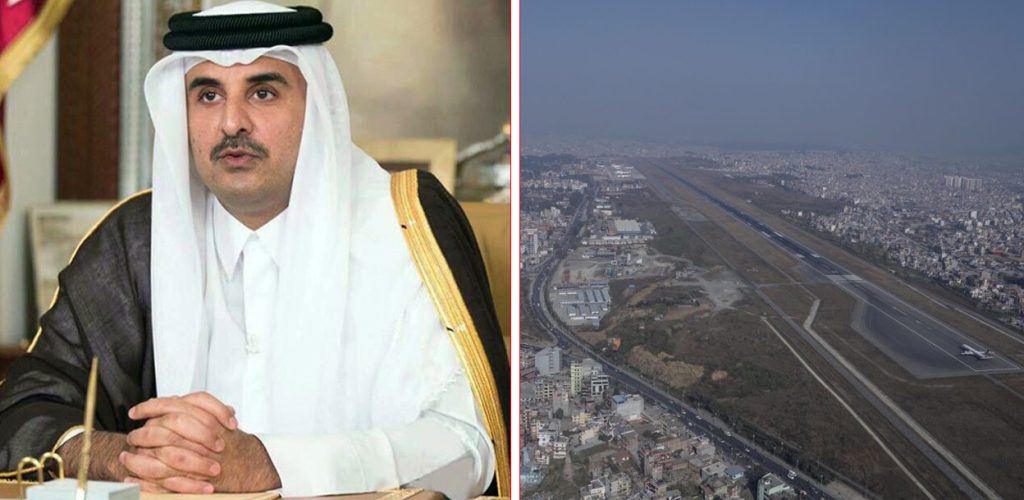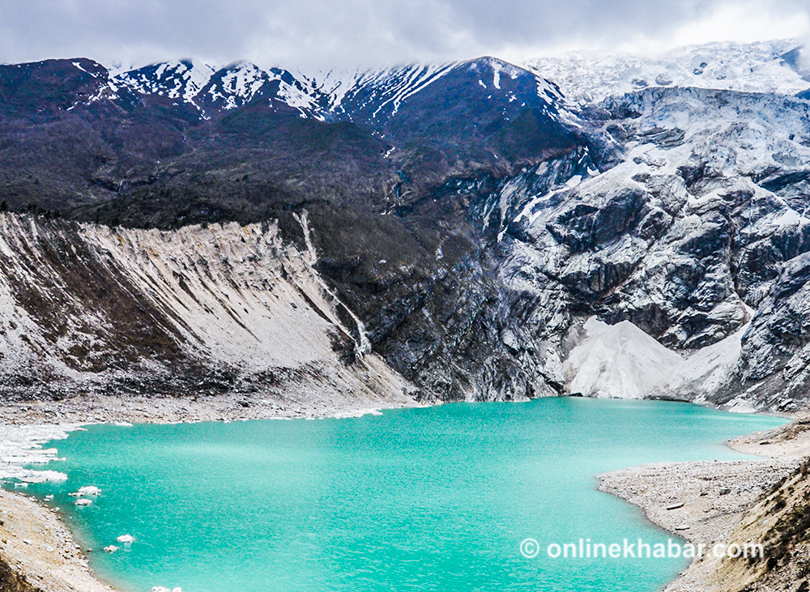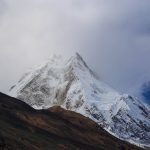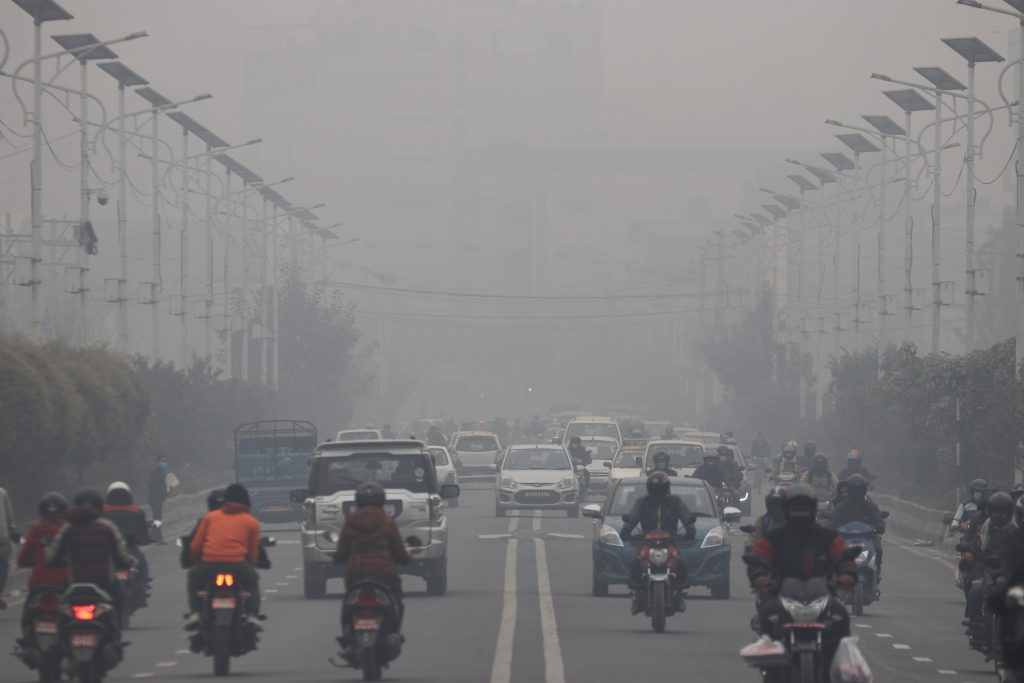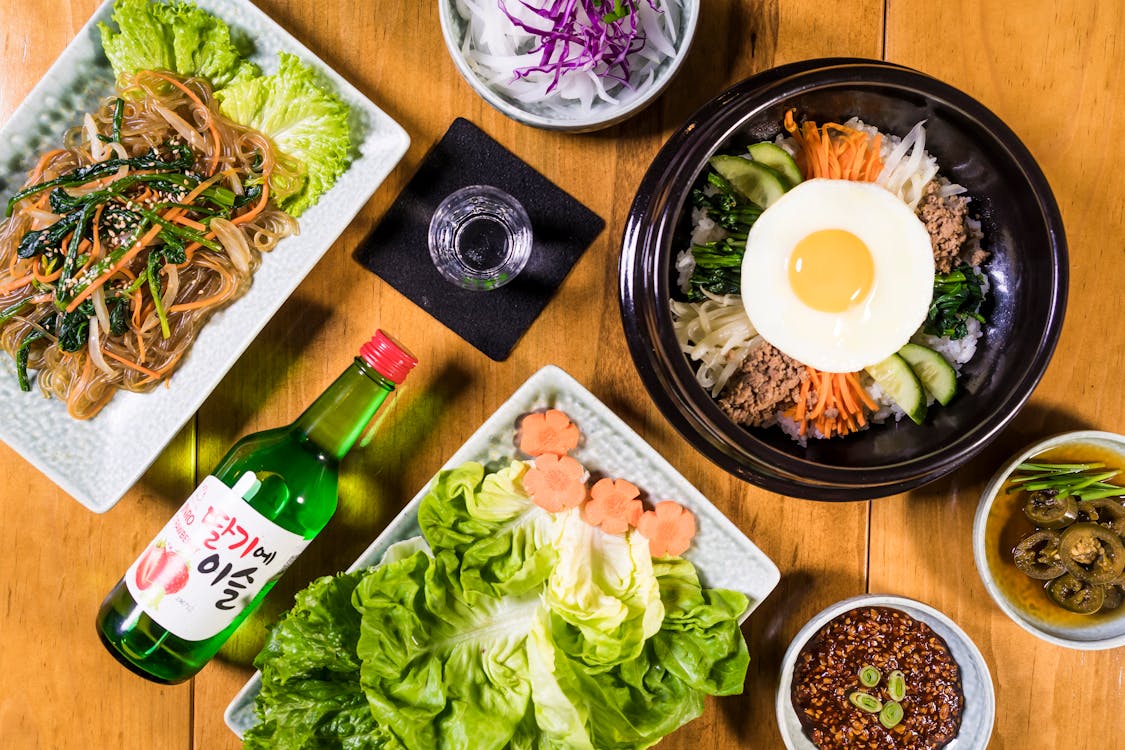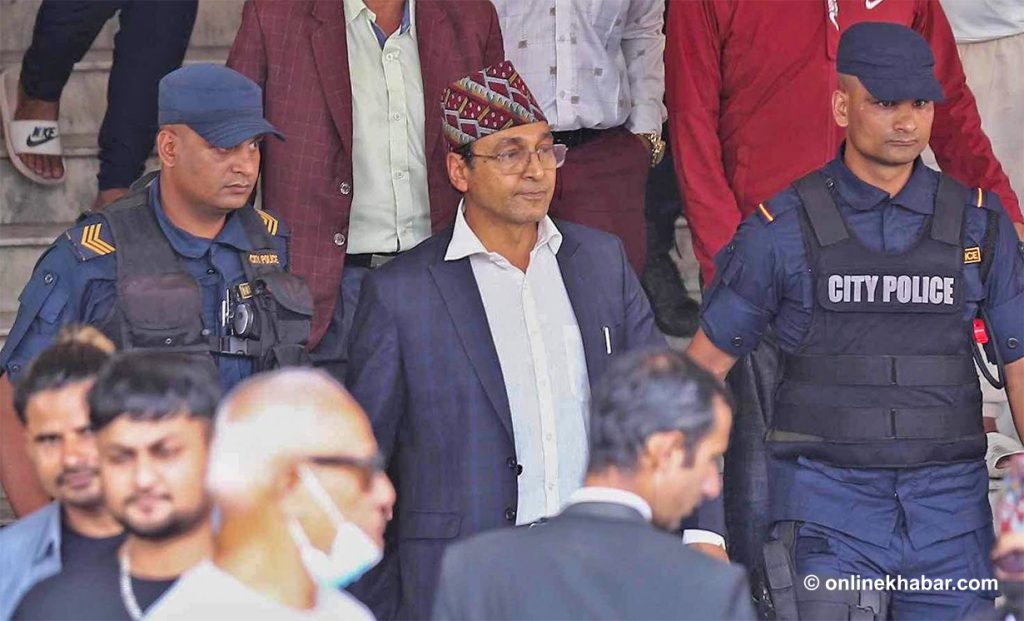
Kathmandu Valley’s religious and cultural heritage–manifested physically in temples, shrines, ponds, wooden and stone carvings – seem a bit out of place in the midst of concrete buildings and traffic. They evoke a yearning to see them in their original, rustic settings. Needless to say, the pollution and congestion also stifle people. So it is a veritable escape, a physical fleeing from this oppressive environs, when your vehicle start going downhill a little east from Boudhanath, from where the road to Sundarijal and Sankhu branch off. You feel like you have just managed to cast off a weight that was holding you back. A bridge and a bend later, you are driving past the green island of Gokarna, the largest and densest forest remaining on the Valley floor.
As you climb to the top of a hill and then descend you come out to a timeless scene. On artistically carved and furrowed fields, depending on the time of year, rice plants or the green stubble of wheat or the yellow carpet of mustard. Tiny figures of various hues—farmers tending to their crops – dot the land. Lifting your gaze to the hill to the south, if you catch it at the right angle, you see a glint on its peak—the gajur of Kathmandu’s oldest temple, Changu Narayan. It’s a classic Kathmandu Valley vista, one that is lost in most parts so is doubly pleasing on the eye.
I had some apprehension in visiting Sankhu, one of the oldest Newar settlements in the Valley, after the earthquake. I feared the ochre-faced houses would have been supplanted by gaudy soulless, concrete ones; tiles from roofs dumped on a newly carved out road, carved wooden windows rotting away in neglect. I knew I would have to confront the town’s transmogrification.
I found enough to lift my spirits. Although the houses around the western town gate were like those in any small town – two story houses, ground floor a shop – further down there were some old buildings. Most of the old buildings were mere architectural relics, reminders of the Rana period, whitewashed with forest green windows. Titled, cracked, roofless: it seemed a strong wind would topple them. They were doomed, not in a condition to be spared when the next road expansion scheme came around. For now, they had a visual appeal, a break from the monotony of identical concrete buildings. And it was quaint to find a post office, padlocked, with a letter box still hanging by its front door. Next to it a Land Cruiser had been entombed, rusting back to the elements bit by bit. Both the building and the vehicle were dwarfed by an immense pipal tree. A signboard on the post office’s façade said that the place was Mann Bisaune Chautari, Resting Place for the Heart.
Resting our hearts and feasting our eyes on the giant tree my companion and I walked on, heading north on the road toward Vajrayogini. We stopped for tea and snacks in the village teashop, thronged by locals sipping tea as they sunned in the square. It was a family-run place. The man of the house (who had the task of washing the cups and plates) turned out to be the antithesis of the shy Nepali villager. He introduced himself to my foreigner female friend, asked her name and, when my friend extended her hand to shake his, kissed it, bowing like Leonardo DiCaprio did when he kissed Kate Winslet’s hand in Titanic.
Around the bend from the romantic man’s teashop, we were in the midst of fields. A small canal ran along the road. In one place, there was a small shrine, a square patch filled with stone statues of gods and a tiny Ganesh temple. On a long stone bench-like structure we found some small, round potatoes. Offerings to the gods? Or had they fallen out from a doko when a farmer had rested his load on the bench? I liked the shrine’s spartan look: no extravagance, no intricate artwork, nothing but devotion given form in stone. Here was a shrine dating back to Kathmandu’s agrarian past.
We continued toward the colorful prayer flags arching over treetops to the north. Below the flags, concealed from view, was the Vajrayogini Temple. The earthquake of 2015 had taken a toll on the temple. The inner sanctum of the temple was now encased in plywood walls. All around it was rubble: bricks, tiles, wooden beams. What had once been a large courtyard was now a cramped space where devotees were burning butter lamps. The Buddha was in residence in the temple on the eastern side of the courtyard, which had somehow survived the quake. I climbed to the ramp on which the sanctum now stood and got a glimpse of Vajrayogini, made an offering to the fund for rebuilding this revered site, then was tricked by the priest into buying another butter lamp, a reminder that no place is too sacred for manipulation.
Our next destination was Changu Narayan, a hike across the fertile farmland from Sankhu to the summit of the Doladri Hill to the south. Half an hour’s climb up the terraced fields across the Manohara River offered a painting-like scene. Neat grids of furrows, with black dots that were manure piles. Farmers were dots of colors. Smaller than them were the white specks of egrets. Laughter and banter wafted up from the fields. Then, like a stone rupturing the tranquility of a pond’s surface, the sight of a man showing a piece of land to a couple. Potential buyers from the city. For how long would the terraces remain farmland? How long before there is a resort where now I was, drinking in the sight of one of the last remaining rural settings in Kathmandu?

It’s a bad idea to visit Changu Narayan on the way to some other place. The third-century temple stands in the middle of a courtyard strewn with some magnificent stone sculptures. The center piece, of course, is the temple. Its ornate tundal (strut) alone would take hours to fully appreciate. After a quick look we headed to our day’s final destination: Nagarkot.
The trail to Nagarkot turned out to be lonelier than I expected. Although it passed through small settlements and, once, even past a large group of picnickers, there were stretches of forests peopled only by adventurous teenagers who had come all that way for some privacy. In one place, as we passed by a trail that descended into the dank forest, we heard grunts. Peering in, I caught the glint of sunlight on a wild boar’s tusk. It was a sounder of boars, digging up the floor for their evening snack. In my excitement I had been careless: wild boars are notoriously territorial, and do not hesitate to charge when intimidated by intruders. The trail was too steep for the bulky beast to be able to run up, I reasoned, fooling myself.
Telkot, the settlement we had been told we could get buses to Nagarkot from, was a couple of shops on a bend in the potholed road to the hill station. We clambered into a bus that had gone on ahead when it slowed down to negotiate a narrow part of the road. There was nothing remarkable about the bus, but its ticket collector had the dourest look I have seen on a Nepali. That accentuated his sharp features, giving him the piercing look of models one sees in magazines.
The bus collector finally smiled. It took a chiding from a girl who had asked the bus to stop some two hundred meters before where it finally halted. He smiled cheekily as he handed her a sack. When he climbed back in and the bus moved, he had the Robert Pattinson look again.
The landscape was bathed in a burnished copper light when the hotels of Nagarkot came into view. Silhouettes of people were visible on an empty space. They were watching the orange orb descend behind the hills. When we got off the bus, it was dark, stars starting to fire up in the sky, Kathmandu engulfed in twilight, hidden from view. Not that it was on our minds. In Nagarkot, you only think of sunrises and sunsets.

Sankhu to Nagarkot via Changu Narayan
Duration: At a relaxed pace, with ample rests, the hike from Sankhu to Nagarkot, with a detour to Changu Narayan takes between six to seven hours. If you do this hike in winter, set out from Sankhu as early as possible to give yourself plenty of time for stops for lunch and snacks.
Grade: Easy. Other than the climb after crossing the river from Sankhu this hike is not taxing—unless you continue on foot from Telkot to Nagarkot.
Route: Get off where there is a big signboard for the Sushma Koirala Memorial Hospital. It is a graveled road going south from the main road to Sankhu. The road will eventually go downhill, with the hospital on your right, to the fields. There are numerous trails after crossing the bridge over the Manohara River that wind up toward Changu Narayan. Ask the people working in the fields or locals you will meet on the trail for directions. Basically, you need to go southwest, following the ridge of the hill to its westernmost point, atop which sits the Changu Narayan Temple.
The trail to Nagarkot from Changu Narayan starts near the vehicle entrance fee collection booth, which is situated some three hundred meters before Changu’s big gateway. Facing east, take the middle road of the three you can see. It’s a graveled road; the one on the left will be the one you came up from Sankhu on and on the right is the paved road to Bhaktapur. Twenty minutes later you will arrive on a hilltop with an antenna. Check with people you meet whether you are on the right track or not. For a while after this there is but one trail until to come to a fork in the trail in a forest. Take the one going uphill (left); there is an abandoned looking resort to the right. You will be walking through dense woods after this point until you meet the paved road to Nagarkot at Telkot. You can get a bus to Nagarkot from there or walk up the eight kilometers.
Transportation: Buses leave for Sankhu at ten-minute intervals from the temporary bus park situated to the south of Ratna Park. Ask the ticket collector to drop you off at the road to Sushma Koirala Memorial Hospital. When you get on a bus to Nagarkot at Telkot make sure you ask the fare first. You might be ripped off if you expect every bus to stick to the standard fare.
Budget: Lunch and dinner and an inexpensive hotel room (shared by at least two people) will set you back 1500 rupees. Carrying 2000 rupees should cover any additional expenses that you might incur.
Sleeping and Eating in Nagarkot
There are numerous eateries along the road at the main bazaar in Nagarkot selling simple fares like noodles, momo, samosa and sel roti. Hotel Marigold has all the amenities you would desire in a hotel: clean rooms, comfortable beds, hot water and tubs. And it’s easy on your wallet. The only downside is that it doesn’t boast a view of the mountains. If you can live with that, this is a bargain. Their food is also delicious, so you can come here for meals even if you stay somewhere else.
Note that on weekends Nagarkot is often booked to capacity. Make reservations if you don’t want to arrive in Nagarkot and only be left with expensive hotels to choose from. For bookings in Hotel Marigold, contact Gokul Lamichhane on 9841430468.
Beyond Nagarkot
You can avoid repeating the bus journey back down to Kathmandu by opting to hike from Nagarkot to Dhulikhel. You can also shorten the hike a bit by going down to Banepa instead of Dhulikhel. From both of these towns on the Arniko Highway you can get a ride to Kathmandu.
The trail to Dhulikhel or Banepa branches off from the paved road that goes up (south) to the sunrise viewing tower. Turn left at the hoarding board for the Bhangeri Darbar Resort. You will walk past a sandstone and ochre-coloured resort. Another resort, sprawling over several acres, will be next. The next half an hour will be a walk in the woods. When you come out in the open again, continue until you come to a tin-roofed shelter on the trail. There will be a trail forking downhill from there. Take it if you want to go to Dhulikhel. Your destination is Bhanjhyang, visible to the southeast as a cleft between densely wooded hilltops. If you prefer to walk down to Banepa instead, don’t turn off from the trail at the shelter. Instead, continue down the same trail. You will soon come to a small village. Ask the people there to show you the trail to Sera. A paved road begins in Sera. You can get a bus there to take you to Banepa.
Changu Narayan Mandir
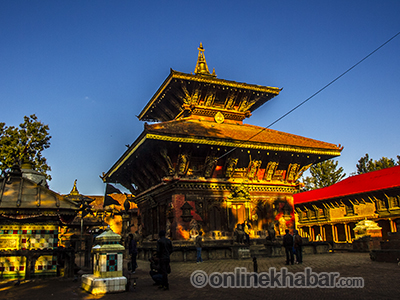
Besides being the oldest temple in the Kathmandu Valley, Changu Narayan is arguably the oldest pagoda temple in the world. Hindus come here to worship Vishnu, who resides in the central temple. The temple is also sacred to Buddhists, who worship the central images as Avalokiteshvara, the bodhisattva of compassion. In the southwestern corner of the courtyard is the Killeshwor Mahadev, a Shiva temple. In addition, Ganesha and the goddess Chinnamasta are also in residence here, occupying shrines in the southeastern corner. Even non-believers wouldn’t feel out of place in this magnificent repository of ancient stone sculptures. The Vishnu image in the northwestern corner is one such example. It was this plethora of statues of gods and goddesses and mythical creatures that led Perceval Landon to remark in his book Nepal:
“One remembers all the wealth of carving of the rest of the Valley; one remembers the woodwork of Peking, the Queen’s golden monastery in Mandalay, and the temples at Nara and Horiuji in Japan. But when all is recalled it is probably to the shrine of Changu Narayan that one offers the palm.”




